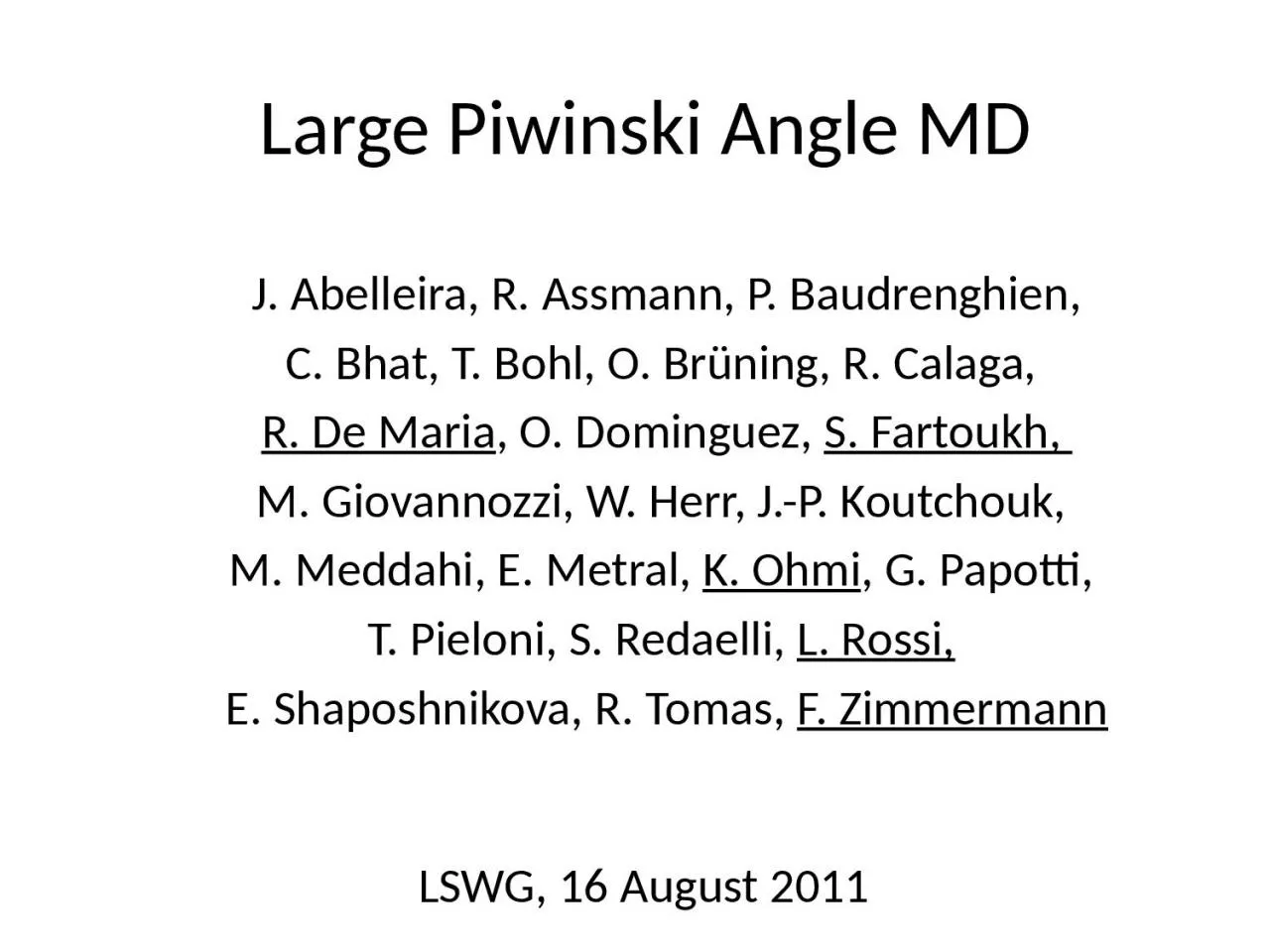

J Abelleira R Assmann P Baudrenghien C Bhat T Bohl O Brüning R Calaga R De Maria O Dominguez S Fartoukh M Giovannozzi W Herr JP Koutchouk M ID: 930291
Download Presentation The PPT/PDF document "Large Piwinski Angle MD" is the property of its rightful owner. Permission is granted to download and print the materials on this web site for personal, non-commercial use only, and to display it on your personal computer provided you do not modify the materials and that you retain all copyright notices contained in the materials. By downloading content from our website, you accept the terms of this agreement.
Slide1
Large Piwinski Angle MD
J. Abelleira, R. Assmann, P. Baudrenghien,C. Bhat, T. Bohl, O. Brüning, R. Calaga, R. De Maria, O. Dominguez, S. Fartoukh, M. Giovannozzi, W. Herr, J.-P. Koutchouk, M. Meddahi, E. Metral, K. Ohmi, G. Papotti, T. Pieloni, S. Redaelli, L. Rossi, E. Shaposhnikova, R. Tomas, F. Zimmermann
LSWG, 16 August 2011
Slide2“
Piwinski angle”“luminosity reduction factor”without crab cavitynominal
LHC
q
c
/2
effective
beam size:
s
*
x,eff
≈
sx*/Rf
“LPA” upgrade
“FCC”
upgrade
Piwinski angle
Piwinski angle: geometric overlap tune shift syn.beta resonances symmetry breaking
primary motivation for
HL-LHC &
LHeC
Slide3motivation
for e+e- colliders crossing angle could lead to large reduction in beam-beam limit & luminosity (DORIS-I→ “Piwinski angle” f, KEKB → crab cavities)little is known about hadron collider beam-beam limit with crossing angle; RHIC & Tevatron: head-on collisionsthe only controlled experiment was done at SppbarSnominal LHC was pushed to f~0.64f will futher increase for smaller-than-design emittance HL-LHC scenarios consider f up to 2.5beam-beam limits experiments so far were done for head-on collisions or very small Piwinski angle
Slide4historical
experiments at SPS colliderK. Cornelis, W. Herr, M. Meddahi, “Proton Antiproton Collisions at a Finite Crossing Angle in the SPS”,
PAC91 San Francisco
f
~0.45
f
>0.7
q
c
=500
m
rad
q
c=600 m
radsmall emittanceSPS tests up to f>0.7 showed someadditionalbeam-beam effect present nominal LHC:f~0.64,ATS upgrade:f~2.5!
Slide5collisions with 285
mradcrossing angleK. Ohmino crossing anglesimulated luminosity lifetime with no crossing angle is 10 times better than with 285 mrad angle (f≈0.65, b*=0.55m, ge=3.75 mm, E=7 TeV)
si
mulations
for nominal
LHC
w
ith higher bunch charge
2 IPs
2 IPs
Slide6transient losses going into collision, beam lifetime and luminosity lifetime for large and zero Piwinski angle beam parameters that correspond to x≥0.03 for q=0 injection energy, collision tunes 2 or 3 ultimate low-emittance bunches per beam 3 bunches would be at/above safe beam limit (5e11) one bunch of each beam collides in IP1, IP5, (IP2) and IP8 Piwinski angle is varied by changing
q
at
maximum bunch
length
longit
. blow
up in
SPS and injected into a 3 MV RF voltage in LHC
to obtain 4sigma_z~1.6 ns (times c) nominal & zero spectrometer strength in IP8
orbit correction when changing spectrometer strength
beams also have to be brought into collision TCT adjustment needed in IP8 (& IP2)?
MD plan
Slide7Beam energy [
GeV]450Optics (injection, squeezed, special)Nominal injection optics (beta*=10 m in 8)
Bunch intensity [#p, #ions]
1.7e11 protons, 1.0-1.2 micron emittance
Number of bunches
two per beam with one bunch colliding in both IP
1+5
and 8, and the other bunch colliding only in IP8
Transv. emittance [m rad]
1.0-1.2 micron (as low as possible)
Bunch length [ns @ 4
s
]
1.6 ns
Optics change [yes/no]
No
Orbit change [yes/no]
Yes, up to
2
mrad half crossing angle change in IP8Collimation change [yes/no]
Change
of TCT
in IP8 (and IP2)?
MD
table - details
Slide8K. Ohmi, KEK
Simulations of the LPA MD
Slide92 IPs not feasible!
K. Ohmi
Slide103 or 4 IPs feasible!
difference very clear for 4 IPsK. Ohmi
Slide11A difference due to crossing angle is
seen with 4IPs, but weak for 3 IPsdoing the experimentwith 4 Ips would be preferred K. Ohmi